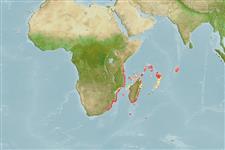Elasmobranchii (haaien en roggen) (sharks and rays) >
Carcharhiniformes (Ground sharks) >
Pentanchidae (Deepwater catsharks)
Etymology: Holohalaelurus: holos (Gr.), whole or entire, i.e., being a form of Halaeurus without any labial folds or grooves in the mouth. (See ETYFish); punctatus: Latin for spotted, referring to dense covering of small brown spots on dorsal surface. (See ETYFish).
Environment: milieu / climate zone / depth range / distribution range
Ecologie
marien bathydemersaal; diepte 220 - 440 m (Ref. 5510). Deep-water; 4°S - 37°S
Western Indian Ocean: endemic to the subtropical and tropical waters of southwestern Indian Ocean, southern Mozambique, off Natal, South Africa and off Madagascar (Ref. 75585).
Status of threat: a common catch in bottom trawls in Natal and southern Mozambique, yet, despite recent biodiversity trawl surveys in that region, not a single specimen has been collected from this area since 1972. ORI data sheets confirm that specimens collected between 1964 and 1972 were apparently abundant, particularly off Mozambique in May 1969, and off Durban in June 1971. The only specimens of this species that have been collected since this date have been those from Madagascar in the late 1980’s and early 1990’s (Ref. 75585).
Lengte bij maturiteit / Grootte / Gewicht / Leeftijd
Maturity: Lm 31.2, range 30 - 32.6 cm
Max length : 35.0 cm TL mannelijk / geslacht onbekend; (Ref. 5510); 26.0 cm TL (female)
Korte beschrijving
Morfologie | Morfometrie
Dorsale stekels (totaal): 0; Dorsale zachte stralen (totaal): 0; Anale stekels 0; Anale zachte stralen: 0. A broad-headed, dwarf catshark with small dark brown spots closely set on a yellow-brown or orange-brown background; small black pores on underside of head and body; no labial furrows (Ref. 5578).
Found on the uppermost continental slopes (Ref. 244). Feeds on small fishes, crustaceans, and cephalopods (Ref. 5213). The adult males are larger than females, a characteristic unusual among sharks (Ref. 244). Manifests partial sexual segregation. Oviparous (Ref. 50449).
Levenscyclus en paargedrag
Maturiteit | Voortplanting | Paaien | Eieren | Fecunditeit | Larven
Oviparous, with one egg-case laid per oviduct at a time. Embryos feed solely on yolk (Ref. 50449). Partial sexual segregation is manifested by greater number of males than females off Natal but not off southern Mozambique.
Compagno, L.J.V., 1984. FAO Species Catalogue. Vol. 4. Sharks of the world. An annotated and illustrated catalogue of shark species known to date. Part 2 - Carcharhiniformes. FAO Fish. Synop. 125(4/2):251-655. Rome: FAO. (Ref. 244)
Status op de Rode Lijst van het IUCN (Ref. 130435)
Gevaar voor de mens
Harmless
Gebruik door de mens
Visserij: van geen belang
Meer informatie
Leeftijd/GrootteGroeiLengte-gewichtLengte-lengteLengtefrequentiesMorfometrieMorfologieLarvenLarvale populatiedynamiekRekruteringAbundantieBRUVS
ReferentiesAquacultuurAquacultuurprofielKweeklijnenGeneticaElectrophoresesErfelijkheidZiektesVerwerkingNutrientsMassaconversie
Tools
Speciale rapporten
Download XML
Internetbronnen
Estimates based on models
Preferred temperature (Ref.
123201): 13.1 - 15.8, mean 15.3 °C (based on 13 cells).
Fylogenetische diversiteitsindex (Ref.
82804): PD
50 = 0.5312 [Uniqueness, from 0.5 = low to 2.0 = high].
Bayesian length-weight: a=0.00355 (0.00176 - 0.00714), b=3.09 (2.91 - 3.27), in cm total length, based on LWR estimates for this (Sub)family-body shape (Ref.
93245).
Trofisch niveau (Ref.
69278): 4.2 ±0.61 se; based on food items.
Weerstandsvermogen (Ref.
120179): laag, minimale populatieverdubbelingstijd 4,5-14 jaar (Fec assumed to be <100).
Fishing Vulnerability (Ref.
59153): Low vulnerability (25 of 100).
